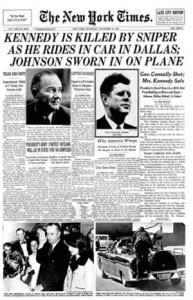
It is ironic that the man who won a Pulitzer for Profiles in Courage, should himself be assassinated while in the service of the public.
Kennedy’s story is not known as much for the textual documentation but rather for the very vivid images from his assasination and the days following it. This drama portrayed on screens across America was a continuation of a public fascination with the President and First Lady in their roles in a metaphorical Camelot.
With technologies of mass communications the death story immediately become wide spread news, told by professionals in the business of entertainment.
The use of traditional print in the role of the death story was not lost but one could say that it was overshadowed by the visceral appeal of the visual broadcast technologies.
A very public obituary – told by professionals
Postman (1985) while reflecting on portrayals of American Presidents in mass media considers that “It is difficult to say exactly when politics began to put themselves forward, intentionally, as a source of amusement.” (p.132), but he recognizes Kennedy as one of the first examples. Kennedy’s death story played out on National television in the same manner as which he and his family’s lives were publicly lived, creating a massively shared public experience by broadcasting through visually centric mass media.
At the high speeds of electric communication, purely visual means of apprehending the world are no longer possible; they are just too slow to be relevant or effective.
(McLuhan and Fiore, 1967, p. 63).
Enter the birth of multimodal literacies which can be seen in the collaboratively told death story of Steve Jobs in The Innovator.